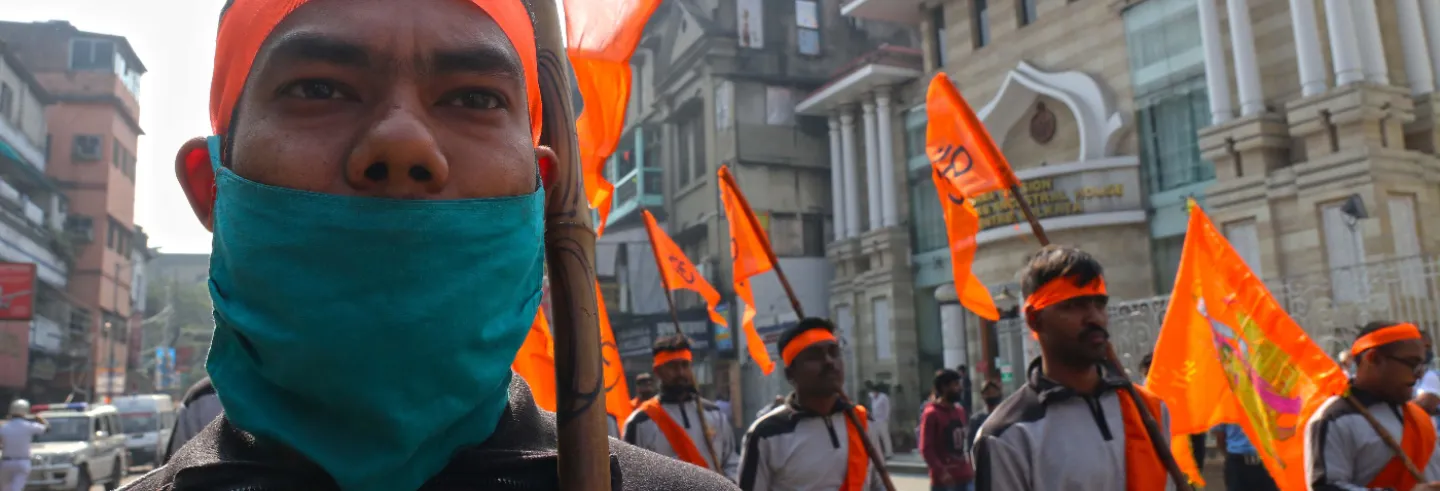Indian youngsters are venting their anger by violating the sanctity of religious symbols, forcible exclusion and subjugation of the Dalits and minorities.
The headlines of Indian newspapers are testimony to this phenomenon.
"Youths attack Class 9 student for not chanting Jai Shri Ram in Jharkhand". "Muslim college student beaten and pushed off a private bus for travelling with a Hindu girl in Karnataka". "Disabled senior citizen 'suspected of being Muslim' thrashed, found dead in Madhya Pradesh". "Dalit youth thrashed for touching food at a wedding in Uttar Pradesh". "Tribal man lynched for drawing water from tube well in Rajasthan". "Mob sexually assaults Adivasi woman".
Civil society organisations have claimed that unemployed young people are being radicalised by some political parties with their anger channelled into igniting communal insecurities, hatred and riots.
However, there are other forms of expressing anger as well. Unemployed youngsters in December last year breached the security of the Lok Sabha and jumped into the well of the House to attract the attention to growing youth unemployment. They are now being tried for terrorism.
Rumours of recruitment scams in government jobs have led to youth anger and even suicides across India earlier as well.
This anger reflects the massive unemployment rate among young people.
According to the Centre for Monitoring Indian Economy, an independent think tank, in the October-December 2023 quarter, joblessness among 20 to 24 year olds grew to 44.49 percent.
The desperation of the government is also evident in its attempts to export youngsters to Israel to take over the jobs of the Palestinian workers evicted after the war in Gaza.
It’s no surprise young people are angry.
This anger can manifest itself in various ways – ranging from suicides, drug addiction and domestic violence to religious radicalisation.
From Independence in 1947 to the 1960s, youth frustration was mainly a collective response to the non-fulfilment of the dreams nurtured by the freedom struggle. Issues like poverty, feudalism, farmers' exploitation by moneylenders and the remnants of the colonial mind-set fuelled youth anger.
The period until the mid-1960s can be characterised as a phase of hope and romance. This reality was also mirrored in commercial Indian cinema. Take, for example, the narrative of the iconic film Mother India (1957). It portrayed the aspirations of a newly independent nation striving for equality, empowerment and social justice.
However, the model of development adopted did not deliver on the promises. The unfulfilled dreams of young India found expression in collective protests, such as the armed Maoist Naxalite movement, assertive trade unions leading major strikes and numerous peasant protests.
These class-based protests were not merely an expression of frustration but an attempt, even if ultimately inconsequential, at realising the dream of building an equitable society.
From the late 1970s to the late 1990s, youth anger was expressed collectively but shaped by class and religious identities. It was spurred by the aspirations for upward mobility being thwarted by systemic injustices and moral compromises.
The mid-1970s also witnessed an economic recession, price rises, food shortages, the fading away of the aura of the freedom movement and a marked erosion in democratic institutions. Hope gave way to frustration and produced a wave of intense anger in younger people.
There were revolts in Gujarat and Bihar which quickly gathered momentum to become the national movement led by Jayaprakash Narayan in 1974-75, before it ended with the imposition of the Emergency.
Along with class-based protests, youth anger also found expression in displaced targets through their participation in communal riots. Communal riots between the periods 1954-69 and 1969-82 almost doubled. This phase also witnessed expression of youth anger in secessionist movement launched by the Sikh militants leading to the assassination of Indira Gandhi on 31 October 1984 followed by the Sikh carnage of November 1984.
The post-Emergency events changed the character of democracy in India dramatically. The economic policies of the government became more dole-oriented. They provided hope to the downtrodden, without actually providing any tangible gains.
This was the beginning of what one might call the third phase of youth anger in India post 1990.
Once again the hopes of young people were thwarted.
A cocktail of frustration about the present and anxiety about the future produced religious revivalism. This awas reflected on the silver screen – the epic Ramayana and Mahabharata serials on TV gripped the nation. Young people were spellbound. The mobilisation of Hindus for building a Ram temple at a disputed mosque site in Uttar Pradesh was launched on September 25, 1990 by BJP leader L.K. Advani, and on December 6, 1992 the Babri Masjid was demolished by the so -called karsevaks -- a case of youth anger taking the communal route.
This period also saw the implementation of neo-liberal economic reforms. The state surrendered to the market but also resorted to populism. Poverty eradication and mitigation of inequalities through positive affirmation (reservation in government jobs) for the intermediate and lower castes was given priority. This resulted in protests by upper caste youngsters who saw job opportunities for them shrinking.
Nehruvian secularism was replaced by an indigenous (Hindu) concept of majoritarian nationalism. Youngsters became flag bearers of competitive religiosity, insecurity and hate. But disturbingly, it would seem that youth anger, except in the large-scale farmers’ protests in 2021-22 where it found collective expression, has also turned inwards.
There has been a marked increase in youth suicides. The share of unemployed youth in the total number of suicides has increased from 1.8 percent to 9.2 percent from 1995 to 2022.
Youth frustration is also leading to drug addiction and domestic violence. The share of domestic violence in registered crimes, for example, went up from 3.1 percent in 1995 to 31.4 percent in 2022.
The government’s failure in job creation is palpable.
The question then is: Will competitive religiosity and hatred continue to be the opiate of India's young people or could it manifest in a different form if the current unemployment situation does not improve?
Originally published under Creative Commons by 360info™.









